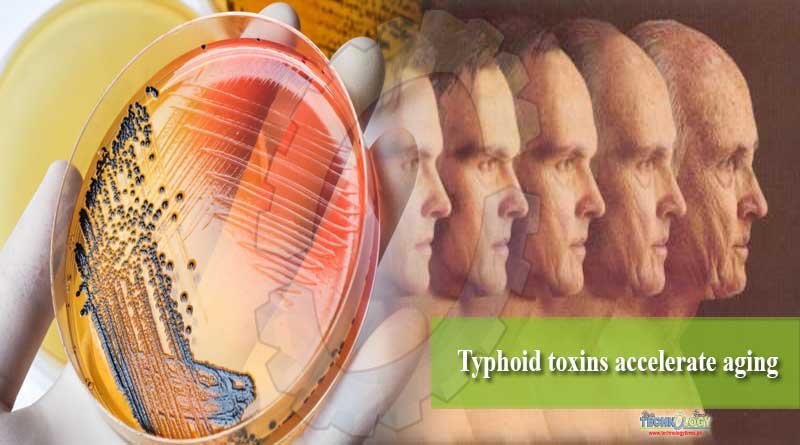Typhoid is a bacterial infection that leads to a high fever, diarrhea, and vomiting. It can be fatal. It is caused by the bacteria Salmonella typhi (S. typhi).

Authors: Zaryab Sajid
The bacterium lives in the intestines and bloodstream of humans. It spreads between humans by direct contact with the feces of an infected person.
Animals do not carry this disease, so the transmission is always human to human.
Typhoid toxins accelerate aging by hijacking DNA repair machines.
Typhoid is caused by the bacterial pathogen Salmonella typhi. It releases the typhoid toxin, which damages cellular DNA.
Human DNA is constantly under threat by environmental factors such as smoking, radiations and UV light, but cells usually have robust DNA repair machines to combat these threats. In the case of the typhoid toxin attacking human cells, it is this repair machine function that gets hijacked.
An experiment was performed to study how the toxin affects the DNA at molecular level. Human cells were infected with bacterial pathogen Salmonella typhi for typhoid. Fluorescent microscopes were used to study how the toxin released by pathogen damaged the DNA at the molecular level, and it was found that it induces a peculiar form of damage; the toxin takes over DNA repair machines and accelerates cellular ageing, rendering them more susceptible to infection.
In time, secretions from infected cells can also affect neighbouring cells causing their aging, leading to faster aging at a cellular level.
Pathogenic bacteria can speed up cellular aging through this toxin and take advantage of this to establish infections. It is possible as infections are often harder to combat and recover from as we get old, which is partly due to cellular ageing, so in this way, infection spreads.
Currently, no routine diagnostics exist for typhoid, which is often confused in the clinic with deadly fevers such as Malaria and Dengue due to which patients receive delayed antibiotic therapy, which causes clinical complications.
However, the discovery of typhoid toxin and its role in the pathogenesis of typhoid fever has provided unique opportunities for the development of needed diagnostic, therapeutic, and prevention strategies to combat typhoid fever.
The unique distribution of typhoid toxin largely restricted to S. Typhi and S. Paratyphi, slong with its strong immunogenicity, suggests that it could serve as the basis for the development of much needed, cost-effective serological tests that could help not only in the diagnosis of typhoid fever but also in the more reliable study of its incidence and epidemiology.
The potential link of typhoid toxin to the life-threatening symptoms of the acute phase of typhoid fever raises the possibility of developing antitoxin therapeutic strategies that, in combination with standard antimicrobials, could improve the outcome of typhoid fever treatment.
Finally, given the good track record of other bacterial toxoids as immunogens (e.g., tetanus and diphtheria toxoids) and the demonstrated immunogenicity of typhoid toxin, its incorporation into vaccine formulations may lead to a much-needed effective vaccine not only against typhoid fever caused by S. Typhi but also against S. Paratyphi A, against which no vaccines are currently available.
However, a strong antitoxin immunity should be able to protect against the disease.